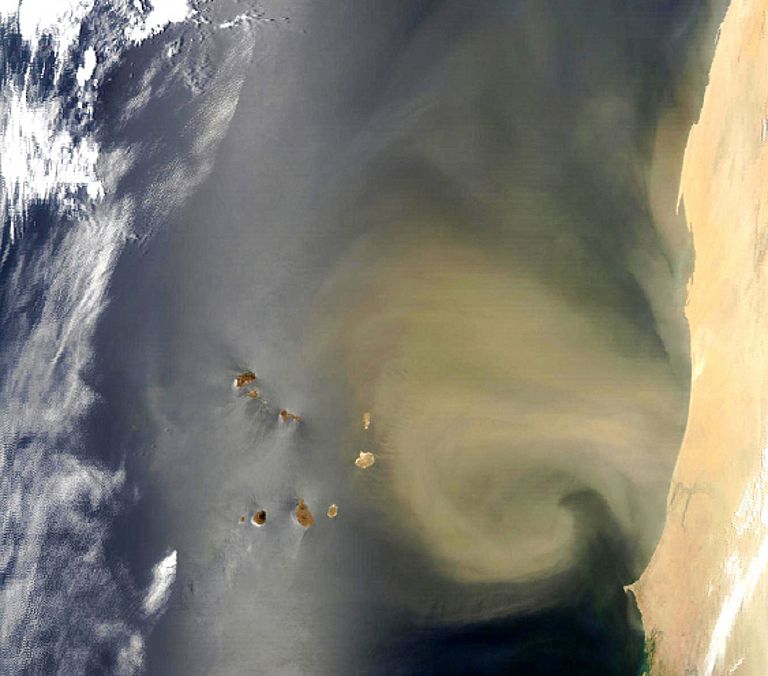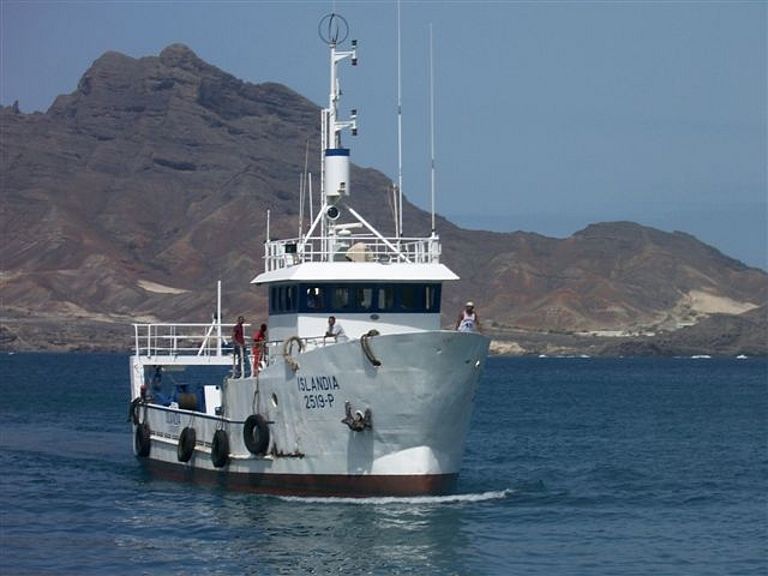Dust for Breakfast
19.06.2009 /Cape Verde Islands, Kiel. Scientists from the Leibniz Institute of Marine Sciences (IFM-GEOMAR) in Kiel, Germany, have returned after six weeks on the Cape Verde Islands, 800 kilometres off the West African coast. They collected air and water samples in the search for a link between Saharan dust storms and the biological productivity of the ocean. The results were intriguing: the waters off Cape Verde contain huge amounts of the recently discovered cyanobacteria “UCYN-A”, an enigmatic fertilizer alga whose characteristics are puzzling to scientists. By feeding Saharan dust to the algae, they are now testing if the abundance of UCYN-A is promoted by the Saharan dust which is so common there.
The tropical Atlantic waters around Cape Verde are very low in plant nutrients. Nitrogen is in especially short supply and limits the growth of the phytoplankton, the tiny plants that are at the basis of the food chain in the ocean. In this area, the nutrients fall out from the sky: Trade winds carry Saharan dust rich in iron and phosphorus which can fertilize the surface of the ocean. This was one of the reasons for the IFM-GEOMAR and other German and UK institutions to establish an observatory on the Cape Verde island Sao Vicente. The Tenatso Observatory now supports long-term measurements of dust and greenhouse gases as well as an oceanographic mooring and regular sampling expeditions by the small Cape Verdean research vessel Islandia.
“We’re testing whether Saharan dust can promote the growth of a particular type of microbe, a cyanobacteria. These cyanobacteria can fertilize the surface of the ocean by fixing the abundant nitrogen gas that is dissolved in seawater”, says Prof. Julie LaRoche from IFM-GEOMAR, co-leader of the expedition. There is plenty of nitrogen gas in the atmosphere but it needs to be "fixed" so that it turns into a fertilizer which is available to phytoplankton. The enigmatic cyanobacteria UCYN-A seems to be a very special nitrogen fixer. In contrast to other cyanobacteria, it is probably incapable of producing oxygen. This in turns enables it to fix nitrogen during the day while others cannot.
The Trade Winds and frequent dust storms that make this area so important for ocean research also complicate the scientists’ work. Dust samples are collected with filters on top of the atmospheric observatory. The collection of the water samples, however, requires sailing on the Islandia for several hours to the ocean observatory located 130 kilometres offshore in a surrounding water depth of 3600 metres. The samples are returned to laboratories that have been established at Cape Verde’s “National Institute for Fishery Development” where the dust experiments are conducted.
„The working conditions are difficult and some trips on the Islandia are like a roller coaster. But overall it’s a very positive work experience, thanks to our supportive Cape Verdean colleagues, the crew of the Islandia, and the general ambience on the islands “, says Stefanie Sudhaus , Ph.D. student at IFM-GEOMAR and member of the last expedition. Loaded with plenty of data from their experiments and confident that the experiments will deliver new discoveries, the scientists have returned to Kiel. During the expedition they were accompanied by scientists from the Max Planck Institute for Marine Microbiology, the Alfred Wegener Institute for Polar and Marine Research, Leibniz Institute for Baltic Sea Research and the Leibniz Institute for Tropospheric Research.
Research Project at the Cape Verde
Scientists from German and Cape Verdean institutes have started collecting data at Cape Verde Observatory Tenatso in 2008, measurements that they hope to continue in order to follow the effect of global change in the tropical Atlantic Ocean. Their research is part of the SOPRAN project (Surface Ocean Processes in the Anthropocene) that is largely supported by the German Federal Ministry of Education and Research (BMBF).
Nitrogen fixers and UCYN-A
There is plenty of nitrogen gas (N2) in the atmosphere but only few organisms are able to "fix" it so that it turns into a fertilizer with biologically useful molecules. Cyanobacteria or blue-green algae are amongst the most important nitrogen-fixers. Until recently scientists thought that single-cell organisms could only fix the nitrogen during the night because during the day, oxygen is released through photosynthesis and inhibits nitrogen fixation by poisoning the enzyme responsible for it. The cyanobacterium UCYN-A doesn’t seem to work like that. It lacks the genes for photosystem II that are needed for the oxygen release and apparently cannot fix carbon dioxide into sugars. Thus, it may utilize light energy in other ways and forgoes photosynthesis, as is normally carried out by land plants and other algae. Although this organism has never been isolated in pure culture, an initial characterization of its genome was published in 2008 by the group of Jonathan Zehr at University of Santa Cruz (Zehr et al. 2008, Science Vol. 322 no. 5904, pp. 1110-1112).
Contact:
Jan Steffen (public relations) Tel.: +49 431 600-2811, jsteffen@geomar.de




